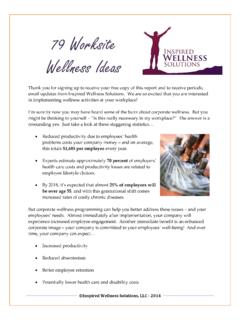Transcription of Prevention and Control of poultry diseases For better farm ...
1 Prevention P ti andd Control C t l of poultry diseases For better farm profitability Yoni Segal FAO Consultant l Module Objectives By the end of this session all participants will be able to: Identify the threats to our poultry and how disease agents might h enter a poultry l farm f Identify the costs of diseases and their Prevention Define the three principles of biosecurity: Segregation & Traffic Control Cleaning Cl i Disinfection Identify biosecurity risks present in a poultry farm Exercise: The questions! 1. How a disease can enter a poultry farm ? 2. What are the costs involved in a disease outbreak ? 2. 3. How can we prevent and Control a disease outbreak ? 4 What are the costs involved in disease Prevention ? 4. In your group discuss what do you know about the question Record your key points on the flipchart Be prepared to present your answer to the group Take about 10 minutes to complete this task What are the threats to poultry farms?
2 The diseases caused by: Viruses Vi (Newcastle disease , Gumboro, Avian Influenza, Duck plague). Bacteria (Fowl Cholera, Salmonella, Mycoplasma, E. Coli, Rimerella anatipestifer). Fungi (Aspargilosis, Mould, Mycotoxins). Protozoa and Parasites (Coccidiosis, Intestinal Worms, lice & mites). Which diseases do you see at your farm? HOW diseases MIGHT ENTR poultry FARMS. Sick birds or Carcasses of Infected Birds Pests People Rodents through Flies, Footwear Stray Animals & Clothing Wild birds poultry Contaminated Feed Bags Farm Egg Flats Litter material DOC Infected Contaminated in the Vehicles hatchery &. or Equipment. from breeders Impure Feed water air The infection pressure in relation to: Regional density Farm density Poor sanitation Poor management Limited downtime Multi-age production Concurrent diseases Other species on farm Q. The costs of diseases : poultry mortalities less eggs (less hatchability). Low production performances less meat slow growth rate poor FCR.
3 Poor product d t quality lit Financial losses to farmers Due to: - mortalities - low performance - medication - decontamination Human infection and death = zoonosis (in case of Salmonella Salmonella, HPAI). Q. How you can prevent and Control diseases In decreased order of efficacy 1. Implementing Biosecurity 2. Vaccination program 3. Medication Often we use these three in varies combination Remember! - Prevention is always cheaper than cure Q. What are the costs of disease Prevention & Control Y should You h ld iinvestt iin: better Housing + Equipment But the most important investment should be in: Training + Education Of yourself and your employees about risk reduction behaviours and changing procedures at the farm llayers broilers b il Cost: $/doz eggs $/Kg Cost of disease Treatment Lost production vaccination Tot: Cost of Prevention Procedures & education better Housing & equipment Tot: USA Data Small commercial producers what are the issues ?
4 Limited resources (money/people/time). High risk because many movements Housing - may not be purpose built - not owned by the producer (rented). Limited technical knowledge and access to information What is Biosecurity Plan Biosecurity plan is a set of practices designed to prevent the entry and spread of infectious diseases into and from a poultryy farm. Biosecurity requires the adoption of a set of attitudes and behaviours by people, to reduce risk in all activities involving poultry production and marketing marketing. Biosecurity plan should focus on Preventing disease agents from entering the farm By keeping potentially infected animals and contaminated objects away from healthy poultry . This requires formation of barriers - Physical and/or p - Conceptual DIRTY AREA. CLEAN. CLEANHOUSE. FARM AREA. AREA. BUFFER AREA = BARRIERS. Dr Yoni Segal Quiz Time 1 Biosecurity is the most effective and the cheapest way to protect your 1.
5 Chickens. a. true or b. false 2. Which elements are the most important for disease 's Prevention ? a housing and equipment a. b. training and education 3. What is it the buffer area? a. clean area b. dirty area c. protective area around the farm created by a wide range of procedures Exercise: The question! 1 Wh 1. Whatt are th the prerequisites i it tot ensure the th good d health h lth andd maintenance of poultry on farm? 2 What is segregation and traffic Control and how to achieve 2. it on a farm? 3. Wh 3 Whatt is i cleaning l i and d how h to t achieve hi it on a farm? f ? 4. What is disinfection and how to achieve it on a farm? In your group discuss what do you know about the question Record your key points on the flipchart Be prepared to present your answer to the group Take about 10 minutes to complete this task The 3 elements of biosecurity A. S. Segregation & Traffic ff Control C. The most effective form of biosecurity prevent contamination B.
6 Cleaning g The next most effective step - when all dirt is removed remove most (80%) contamination C. Disinfection The h lleastt reliable li bl step t - depends d d on th the quality lit off cleaning l i might kill any remaining contamination Q. Prerequisite: Good bird management g ensuring g the g good health and maintenance of poultry on farm Provide adequate feed, water, temperature, airflow Keep K records d off the th flock fl k : source and number of birds being placed in the farm how many birds died or culled each day (in number and %). daily feed consumption (in tot and in grs/bird). daily water consumption (in Liters). vaccinations, medications, vitamins Do you keep any records at your farm? Q. A. Segregation & Traffic Control The strongest form of biosecurity and where all effort should be placed !!! Preventing disease agents from entering the farm by keeping potentially infected animals and contaminated objects such as clothing clothing, footwear footwear, vehicles vehicles, equipment equipment, etc, away from healthy poultry .
7 This requires q formation of barriers,, Nothing crosses these barriers unless it has to. The barriers can be: physical - lock on doors, fence & gate, distance temporal - time break in between farms' visits procedural - washing hands and feet feet, changing footwear and outer clothes, vehicles kept p off the farm Barriers in descending order of efficacy 1. Locks + Chains Prevent unauthorized people from entering into the chicken house, risking the transmission of diseases 2. Screened walls and windows fishnet in use in Thailand Prevent contact of poultry inside the chicken house with wild and domestic animals and birds from the outside 3 Strict procedures for farm entry 3. All workers or visitors must wash hands and feet with soap before entering the chicken house All workers or visitors must change or cover clothes and footwear before entering the chicken house (wear farm's clothes). All workers or visitors must clean and disinfect isinfect footwear between sheds by using a footbath or change footwear Prevent contact of poultry inside the chicken house with diseases agents that might be carried from the outside on people hands hands, cloth or footwear Annex at the chicken house entrance with dirtyy and clean side Chicken shed Clean area Shoes Soap and water Dirtyy area Door F.
8 Farm yard d Only essential visitors allowed on farm such as: veterinarian and service man. never allowed in: chicken/duck & eggs dealers disease Control Area STOP Visitors allowed in under strict conditions (. (wash, h change h off cloths, l th restricted t i t d movement, t etc). t ). Help us maintain flock health Prevent contact of poultry inside the Please keep out chicken house with people from the Phone: -_____. outside that might carry disease on their hands, cloth or footwear Conducting farm business Selling live birds Transport poultry offsite to poultry dealers Transfer to p poultry y dealers at yyour farm g gate (do not let the dealer on your farm). Transport to a live bird market Sell directly from the farm gate (do not let people in). Selling eggs Sorting the eggs into flats to be taken off the farm (using plastic vs. paper flats). Never bring paper egg flats back from the market to the farm If selling eggs directly from the farm, sell them at the farm gate ((do not let people in)).
9 Only y essential vehicles and equipment allowed on farm Vehicles should be left outside the farm area - might allowed into the farm in special condition following strict washing and disinfection - parked at least 30 mt from the house O. Only l essential i l pieces i off equipment i allowed ll d iinto the h ffarm following strict washing and disinfection F i ti box Fumigation b 4 S. 4. Separating ti bibirds d bby species i Never keep together in the same house or same farm birds of different species f example: for l chickens hi k andddducks k or gees Remember! Waterfowls are often a silent carrier of Avian Influenza or Newcastle virus 5. All-in All in all all-out out management system = single age Don't add new birds to a flock Prevent spread of diseases from age group to another on the same farm (due to different health and immunological status). Allow simultaneous depopulation of facilities between flocks and periodical clean-up and disinfection of all h houses andd equipment i t tto reduce d iinfectious f ti pressure or to break the cycle of disease 6 Fence + gate + warning signs 6.
10 Fence around the farm + gate + warning signs to Control the movement into the farm of people, vehicles, equipment and other animals that might carry diseases into the farm from the outside disease Control Area STOP. Help us maintain flock health Please keep out Phone: -_____. 7 Keeping 7. K i minimum i i di distance t b between t poultry lt ffarms Keeping minimum distance between poultry farms When there are number of farms in a short distance, there is a possibility to form a cluster of farms with good coordination, all birds are placed and marketed at the same time = single age Keeping minimum distance between poultry farm and LBM. Prevent or reduce the spread of diseases from infected to healthy birds Q. B. Cleaning g Cleaning of housing, vehicles and equipment is the next most effective step, cleaning remove 80% of contaminants When all dirt is removed, there is little organic material left in which disease agent may be protected and carried Cleaning g means that the surfaces of the object j must be visibly y clean with no dirt left that is visible to the eye Cleaning Cl i needsd effort ff t scrubbing, bbi b brushing hi and d hi high h pressure washing with detergent and water What should be cleaned and when You should ensure regular cleaning before entering into the farm: vehicles and equipment (syringes, de-beakers, egg trays).















